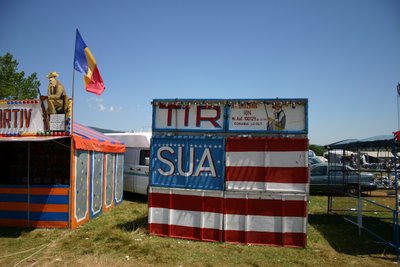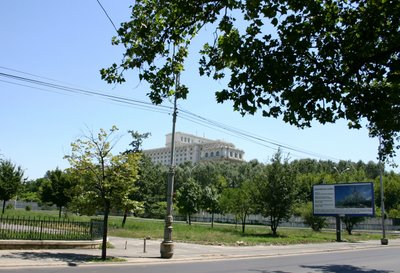
Friday, December 22, 2006
Sunday, December 17, 2006
Saturday, November 18, 2006
New Europe
Friday, November 10, 2006
Remake

My good friend Daniel Gontz will soon open his "Remake" show at Dan Popescu's gallery in Bucharest... This picture is a remake of one of SubReal's iconic images from the 'Framing the cities' series. The colour picture shows Daniel and Mr Iosif Kiraly at work...

Friday, October 20, 2006
Thursday, October 19, 2006
Holy Grill v2.0

The Holy Grill was part of Janek's Simon Madagascar exhibition opening last Thursday in Lodz... Different from last time I did it, now it had two grills. There were 800 saussages cooked and two sheep were especially sacrificed for that. I was quite happy to hear about that as it brought more power to the piece, placing it stronger into the Old Testament context. Anyway, people were happy to eat and the hardcore Polish catholics didnt make themselves heard.
Sunday, October 08, 2006
Tuesday, October 03, 2006
Friday, September 08, 2006
The Revolution Will Not Be Televised




This is my piece for TVR - Romanian State Television's 50th anniversary. Several artists were invited to produce a work which would be kept on the television premises for a year. My piece consists of a comment on the autenticity of the Romanian Revolution of 1989, supposedly the first revolution ever to be transmited live on television. The banner is up from today onwards and will (hopefully) stay up for a whole year.
Thursday, September 07, 2006
Wednesday, August 30, 2006
About Vlad Nanca
Today I made it to VVORK and they linked to this blog although I never meant it to be my webpage or anything. Now I feel that I need to post some links to sites where my stuff can be seen on the internet.
The flags (or "I do not know what union I want to belong to anymore") are from "Vlad Nanca lives and works in Bucharest" a show I did in my apartment (aka the 2020 Home Gallery) in 2003. Several exhibitions took place in my flat, you can see reports from some of them on the 2020 website.
My works from 2004 and 2005 can be seen on Offset - a compilation of artworks by young Romanian contemporary artists.
I do alot of photography and some old work can be seen here.
I'm a big fan of street art and I have a street art photolog. I love the city I live in and with some friends we made a blog about it - Bukresh blog.
Here is excerpt from a text by Mihnea Mircan, COMMUNITY WORK – A Report, the bit that refers to my work:
Working in a subREAListic vein (in the sense defined on one occasion by Călin Dan, as revealing and playing with the supreme state secrets – poverty and the ridicule), the artist Vlad Nancă is the initiator of the already mentioned 2020 Home Gallery and of the ‘Începem’ (‘We’re getting started’) internet discussion group and fanzine – processes which gelled a collective of artists of diverse backgrounds around the ironic credo that Romania will be the epicenter of the art world in the year 2020. This collective practices a D.I.Y, low-budget post-institutional attitude, through projects like the intended creation of a network of home galleries, with art works traveling by post. As an artist, Vlad Nancă reacts to the misuse of national symbols, the backdrop of false heroics on which the nation seeks to project its daily life and the political channeling or appropriation of such practices. One victim of an excessive yet perfectly ignorant adulation is the poet Mihai Eminescu, mounted on a pedestal of paper and vociferousness from which he seems to command the nation’s self-reflection and to guide its natural propensity towards the absolute, the latter being probably the most stable preoccupation in Romanian culture. The idiotic and fundamentally destructive stardom thus achieved by the poet, completely isolated from the life of culture since rendered “ultimate” and “unique”, is counteracted by Vlad in a piece called ‘The Eminemscu Show’, which works either as a stencil graffiti in the streets or equipped with a heavy gilt frame in a gallery context. Joining hands we have the poet of longing and the lyricist of unhappy childhood or sworn revenge, a figment of pop marketing and the restless gesticulation of a culture which secretly perceives itself as second-rate. The Slim Shady of late Romanticism does stand up, with a chorus of academics, journalists and cultural workers ready to acclaim genius and to demand reverence in its name. The same strategy of “fuse and confuse” is deployed in a work which inverts the “logos” on Communist Party and European Union banners – the misplaced hammer, sickle and 12 stars accurately describe the ideological confusion that makes political life in Romania such a dispiriting spectacle and such an exercise in futility. ‘30 Years of Social History’ departs from the iconic significance of Dacia, an imported model of Renault from the ‘70s which was transformed into the national car and mass-produced until recently with almost no improvement involved. Vlad’s fast-paced slideshow has the car, with its seemingly inevitable design, parade in various cityscapes more or less affected by communist urbanism. Attention gradually shifts from the pitiful design of the car to the cityscape itself, oddly unitary in its desolation. All images become equalized in a sort of social numbness, into which the car punches always the same hole, metaphorically readable as rupture of the social tissue. The final slide has the Dacia positioned symmetrically in front of the House of the People, the crown jewel of communist architecture in Bucharest, in all its dumb grandeur. The House of the People must rank high in some top 10 of difficult buildings to look at, come to historical terms with and digest culturally. It is a flaccid expression of communist absolute power, an empty interdiction directed towards the city, isolated from the life outside and folded upon itself in a megalomaniac entanglement of decoration, abuse and meaningless glorification. It, and the adjoining Civic Centre, gridlocked a sizeable portion of the city. I must confess I haven’t checked whether it still is the second largest building in the world, yet it certainly belongs to a universal architectural freak show as one of the twisted wonders of late modernism. Another work by Vlad resorts to the edifice from a different perspective. When the news spread that the Romanian Orthodox intends to erect a monumental ‘Cathedral of National Redemption’, the artist proposed a morphing, a quick solution to both problems: the House itself can become a cathedral, by simply adding the generally recognizable signs of piety in the public sphere, dome and cross. No other adjustments would have been necessary to accommodate the new breed of megalomania, in the context of a perverse alliance between the ideology behind the House and the one evinced by the plans of the Orthodox Church, in a country trapped somewhere between the 19th and 21st century, still boasting its role in the Middle Ages as “defenders of faith” and where populist initiatives can display a remarkable opacity to the present and its imperative questions. Made last year, Vlad’s proposal brought together theoretically disparate realities; yet recent developments have confirmed what appeared at first to be no more than a quirk. Those disparate realities have come to articulate a closed, inescapable network, proving the artist’s derision prescient. After a few possible locations for the Cathedral were rejected, the site under consideration now is precisely the lawn in the back of the House, the only impediment being that the foundation of the Cathedral might affect the underground defense tunnels which spread from the House towards other locations vital for national security. This enfolding of military secret, conspiracy theory, late and falsified religiousness, megalomania and populism qualifies the House as a strange attractor for misplaced ambitions and unspoken political desires, as well as the perfect backdrop for acting out the post-communist syndrome. If the plan of church-plus-government is to enlist the support of that segment of population that needs this cathedral, and meanwhile safeguard the imperial isolation of the House, then the project of the Cathedral can work. If the plan is to cover the whole idea – and necessity – of urbanizing the House with a thick layer of ridicule, then the project is truly advisable. If the grandiosely confused plan is to build a sacred counterpart to the obscene violence of the House of the People, then the project is ill-advised. So is any thought that this might infuse life to an entire area ravaged by communist urbanism, or trigger the post-traumatic process.









































